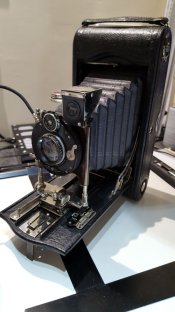Mr. Rusty,
I like to use 5x7 paper cut to 3.75x7. The extra width helps hold the paper in place when you close the back. 122 is a great size for contact printing.
It's not hard to set up a system for swapping paper in a changing bag.
For contact printing onto normal photo paper ( not alt process ), it can be helpful to reduce the contrast in the paper negative. There are several ways to go about this: (there was a url link here which no longer exists) is good and will also increase the speed by around 1 stop, I like to use VC paper and a yellow filter. Joe VanCleave, who is a master of paper negatives, prefers graded paper. Once you've got the hang of what a negative that prints well looks like, you can try overexposing just a little ( 1/2 to 1 stop is a good starting point ) and using dilute developer. ( Dektol 1:8, maybe slightly used, is a good starting point even if you don't overexpose ) I used to save my dektol from printing sessions to use with paper negatives and keep it up to a week or two, beyond when it would be useful for making prints. These days I use LPD at the same strength that I use for printing.
With the papers I've tried ( adorama brand VC and Ilford MGIV ), I get approximately:
ISO 6 untreated for contrasty negatives good for salt printing.
ISO 12 pre-flashed
ISO 3 pre-flashed holding a yellow filter in front of the lens.
You'll learn to adjust for time of day and the amount of blue light...
So there will be two ranges of shutter speeds that are useful. If it is bright enough, you can open up the lens and use the shutter. On a tripod of course, I've used up to 5 shutter releases to build up enough exposure. I usually figure if I can make the exposure with less than about 1/6th second with an available aperture, this can be a good approach. The other option is to stop way down, use bulb mode, and make a longer exposure. I figure if the exposure can be over about 3/4 second, this can work. Exposures between 1/6 and 3/4 of a second are not convenient ( too quick to judge w/ B mode, and too long for the available shutter speeds ), but this is easy enough to work around. There is no situation where one or the other approaches will not work.
Paper is less forgiving than film in terms of exposure. You will capture about 2 stops of information on either side of your chosen exposure, 2.5 in the best circumstances and I usually only envision 1.5. Often you will need to decide which side to lose. It is nearly impossible to capture good detail in bright clouds and have more than a silhouette foreground, so usually you will let the sky go white and expose for your subject. This makes wonderful, atmospheric old-fashioned looking prints, reminiscent of photos from the turn of the century.
Have fun!










 it will help with the contrast when you print,
it will help with the contrast when you print,




